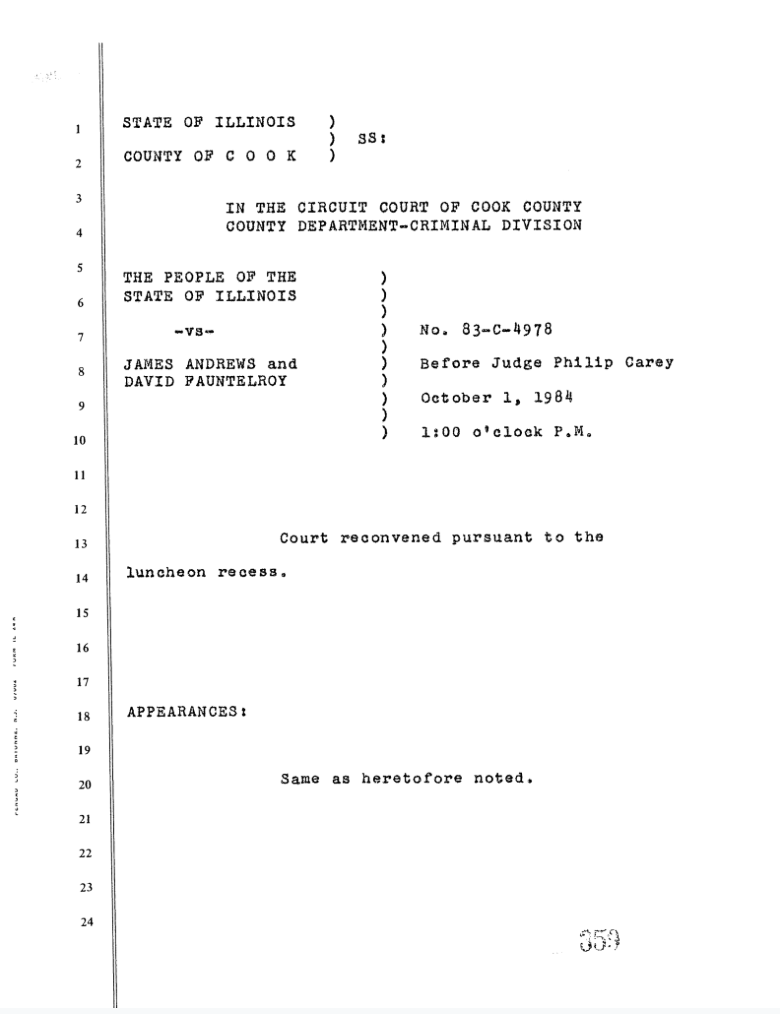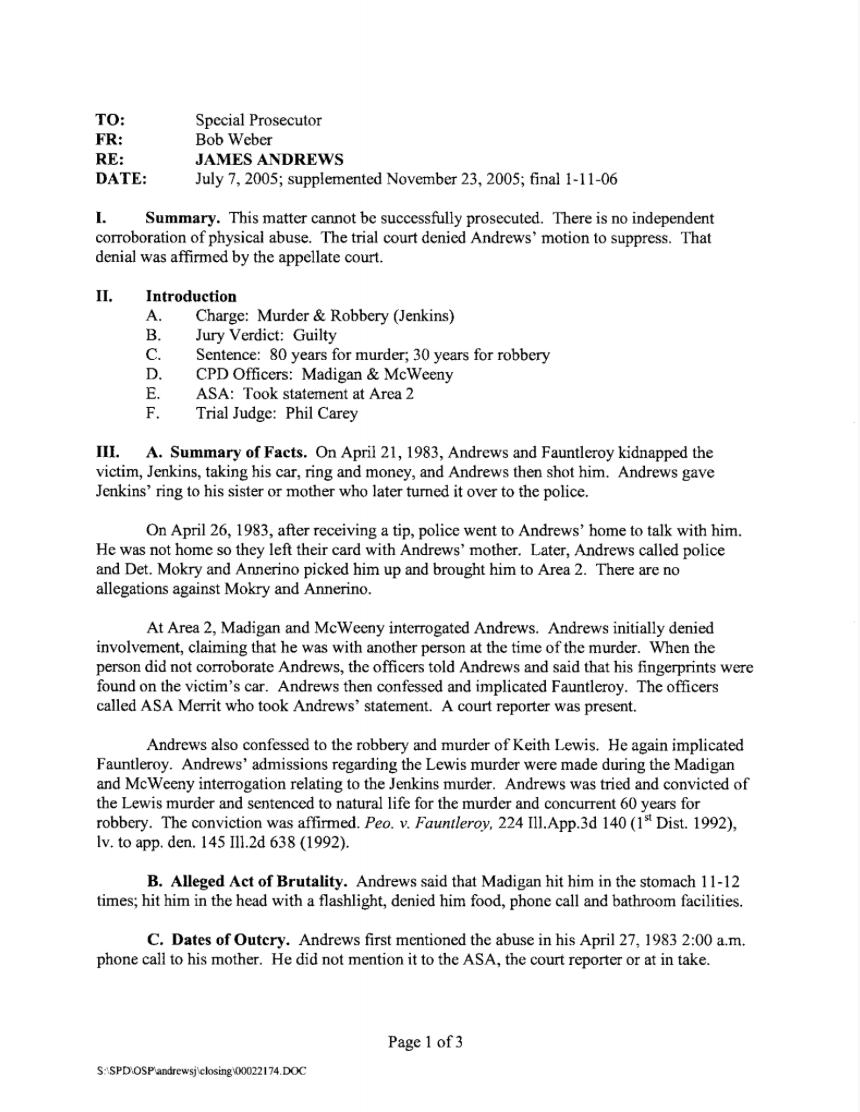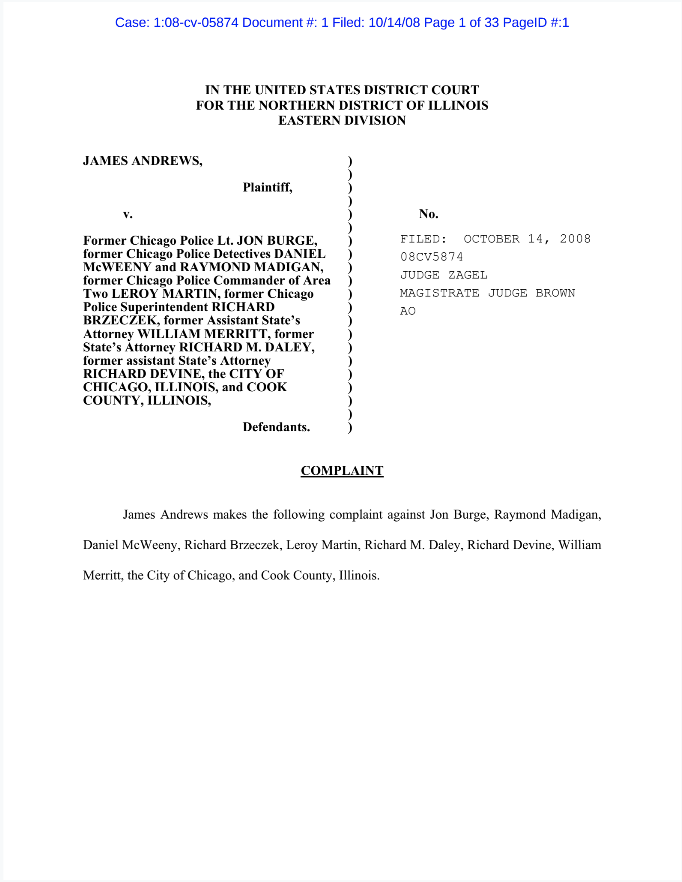The following profile has been republished with permission from The National Registry of Exonerations.
At about 1:30 p.m. on April 26, 1983, Chicago Police Detectives Raymond Madigan and Daniel McWeeny brought 21-year-old James Andrews in to the Area 2 Police Headquarters on Chicago’s South Side, saying they wanted to question him about a dogfight.
But the questioning quickly turned to the unsolved murders of 19-year-old Kevin Lewis and 20-year-old Floyd Jenkins, who had been shot to death in separate incidents on the city’s South Side. Lewis was killed on March 30, 1983 and Jenkins was killed April 22, 1983.
Andrews accused of murder, tortured
The detectives accused Andrews of the murders. When Andrews—who had no criminal record—denied involvement, they beat him, using their fists and a flashlight, over a period of nearly 10 hours. Andrews finally signed a confession saying that he and a 22-year-old acquaintance, David Fauntleroy, had robbed Lewis and that Andrews had fatally shot Lewis on March 30, 1983.
The detectives then arrested Fauntleroy. Before they went to the station, the officers drove to an unlit wooded area. There they parked, turned off the engine and lights and sat in silence for about 20 minutes. Then, one of the officers said, “Look at him, that’s how they look when they’re guilty.” After another silence, one of the officers said, “How would you like it if I used this on him?” and pointed a pistol at Fauntleroy’s head. Fauntleroy was so terrified, he urinated on himself. The officers then drove him to the station where they began interrogating him about the Lewis murder.
When Fauntleroy denied involvement, he, too, was beaten. When he refused to confess, police brought Andrews to the door of Fauntleroy’s interrogation room and said that Andrews had confessed and implicated him. But Fauntleroy still denied involvement. After being threatened with the death penalty and beaten again, Fauntleroy finally signed a confession. Police conducted a search at Fauntleroy’s home and recovered jewelry that they contended belonged to Lewis.
The detectives then returned to Andrews and continued their physical assault as they questioned him about the Jenkins murder. Andrews soon signed a confession to that murder as well.
Andrews was finally allowed to call his mother at about 3 a.m. on April 27. She would later testify, “He said that they beat him, they beat him and made him sign a confession…He said he was afraid they would kill him.”
Andrews and Fauntleroy both challenged their confessions as being coerced, but the detectives denied any abuse, and the motions to suppress the confessions were denied.
Andrews confesses
There were four trials. Andrews was convicted of the murder of Jenkins on March 8, 1985. He was convicted of the murder and robbery of Lewis on April 10, 1987. Fauntleroy was convicted of the Lewis murder on August 26, 1986. He was acquitted of the Jenkins murder.
The confessions and the jewelry that allegedly belonged to Lewis were the only evidence linking the men to the crimes.
Both men were sentenced to life in prison. Their convictions were upheld on appeal.
Burge evidence revealed
Over the ensuing years, evidence emerged that detectives under the command of Lt. Jon Burge, including Madigan and McWeeny, regularly tortured suspects during interrogations. In total, more than 100 convicted defendants alleged that they had been tortured into confessing through beatings, threatened executions (a gun was put in the mouth of one suspect), and electroshocks with a hand-cranked generator. One defendant was stripped and held over a radiator, leaving burns over his back.
In 1999, in a case brought by another defendant through a federal petition for a writ of habeas corpus, a federal judge ruled that it “is now common knowledge that in the early to mid-1980s, Chicago Police Commander Jon Burge and many officers working under him regularly engaged in the physical abuse and torture of prisoners to extract confessions.”
Andrews’ charges dismissed
Andrews filed a state post-conviction petition in May 2004, arguing that, had the evidence of the “regime of torture” been known at the time of his trial, his confession would have been suppressed. On October 15, 2007, Cook County Circuit Judge Thomas Sumner vacated Andrews’ murder convictions and on February 1, 2008, the charges were dismissed.
Fauntleroy filed a similar post-conviction petition in May 2008. On January 8, 2009, the petition was granted and his conviction was vacated. The following day, the judge entered an order dismissing the case and Fauntleroy was released.
Both men filed federal wrongful conviction lawsuits against the City of Chicago, the officers, and Cook County. Fauntleroy settled his lawsuit for $1.8 million. Andrews settled his case for $1.8 million as well.
– Written by Maurice Possley





